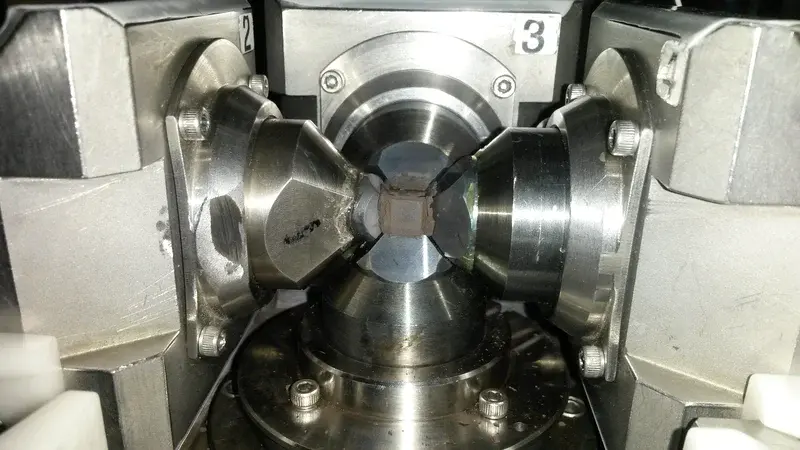
Labquakes from high-pressure synchrotron experiments
by Thomas P. Ferrand, Earthquake Research Institute, Tokyo, Japan
The D-DIA is a large-volume triaxial press able to confine material up to tens of gigapascals. Here, the six anvils of the D-DIA squeeze a cube of boron-epoxy, in which the deformation assembly is located. The 6-mm truncation allows to easily reach pressures between 1 and 4 GPa in millimetric samples. On the picture, four of the six anvils are visible and the cube shows its shape after deformation.
Most of the anvils are made of tungsten carbide, but for X-ray diffraction experiments two of the four horizontal anvils consist of sintered diamond, which is almost transparent to X-rays. On the left side of the picture you can see that the diamond anvil holder is truncated in order not to hide the X-ray diffraction pattern.
The plus of our experiments actually is very subtle on the picture. On top of the right anvil, you can see a white wire. Actually, each anvil holds a piezoelectric transducer, connected to the computer via such wires. Indeed, in this set of high-pressure deformation experiments, we use synchrotron technology and acoustic emissions monitoring in the same time to understand how earthquakes are triggered.
Categories
- Earth Magnetism & Rock Physics (351)
- Geochemistry, Mineralogy, Petrology & Volcanology (990)
- Geodynamics (371)
- Interdisciplinary/Other (841)
- Laboratory (112)
- Seismology (210)
Location
- North America (769)
- Northern America (605)
- United States of America (401)
- Exact location (-87.9803 W, 41.7144 N)
Tags
- olivine (6)
- earthquake (22)
- anvils (2)
- x-rays (2)
- science (6)
- natural science (10)
- experiment (8)
- ddst (3)
- dehydration (2)
- antigorite (3)
- peridotite (6)
- lab (5)
- quake (2)
- labquake (2)
- synchrotron (1)
- aes (1)
- acoustic emissions (1)
- artificial rock (1)
- earth sciences (2)
- high pressure (1)
- pressure (1)
- mimic nature (1)
- diamond (1)
- tungsten carbide (1)
Colours
Image properties
3264 × 1836 px;
image/jpeg; 2.2 MB
Camera:
Samsung GT-I9195
Taken on 17
April
2015
Submitted on 14 February 2018
Licence
Creative Commons Attribution 3.0 Unported (CC BY 3.0)
Credit
Thomas P. Ferrand (distributed via imaggeo.egu.eu)
Share
Appreciate
Report